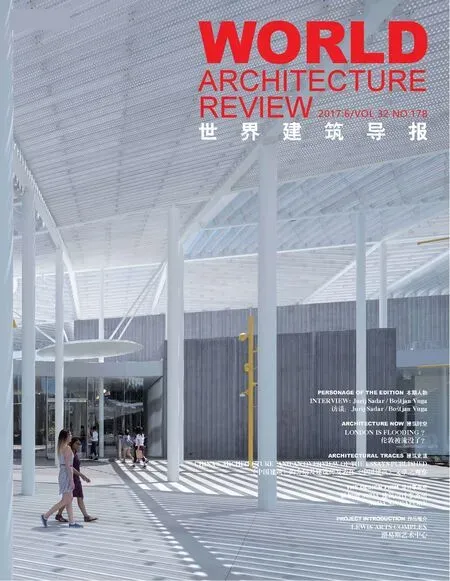伦敦被淹没了?
作者:林纯正CJ.Lim
伦敦大学巴特莱特学院建筑与城市学教授
伦敦被淹没了?
作者:林纯正CJ.Lim
伦敦大学巴特莱特学院建筑与城市学教授
“鬣蜥栖息在写字楼和百货商店的玻璃窗上,冻僵的脑袋生硬地摆动,镜中同伴在四处爬行。如果没有这些爬行类动物,淹没过半的写字楼四周的泻湖和河湾本应是一道另类的、梦幻般的风景,但鬣蜥和皇冠鬣蜥的存在瞬间将人们从梦幻之中带回现实。随着鬣蜥端坐在废弃的会议室内,伦敦已被爬行类动物占领。”——詹姆斯•巴拉德《沉没的世界》(1962年)
Perched in the windows of the office blocks and department stores, the iguanas watched them go past, their hard frozen heads jerking stiffly. Without the reptiles, the lagoons and the creeks of office blocks half-submerged would have had a strange dream-like beauty, but the iguanas and basilisks brought the fantasy down to earth. As their seats in the one-time board-rooms indicated,the reptiles had taken over the city.’ – JG Ballard, ‘The Drowned World’, 1962
巴拉德笔下的伦敦进入了新的三叠纪,面临环境压力,人类思维开始退化。冰盖消融导致西方国家变为热带泻湖国家,而随着城市部分被海水淹没,人类开始进入极端反乌托邦社会。海盗疏浚了泻湖,大肆抢夺往日的财宝,部分人类占领了露出水面和植被的高层建筑。1作家威尔•塞尔夫认为,巴拉德的童年在上海度过,在上海巴拉德亲身经历了多次洪灾;二战期间,日本入侵对巴拉德性格形成产生影响,乃至造成如同世界末日般的体验,“尽管巴拉德无意构建一个生态寓言,但这是他的沃土,他情不自禁地塑造了一个生态寓言。”2小说的多个版本通常采用淹没过半的伦敦这一令人震撼的景象作为封面,图中圣保罗大教堂、伦敦塔桥等伦敦地标式建筑藏身于繁茂的藤蔓(由热带植被的枝叶组成的林冠)之中,借此反映浸泡在污水中破败不堪的建筑。
“伦敦已经深受气候变化的影响。伦敦计划中指出伦敦极易遭受洪水、地面沉降、高温和供水短缺的影响。”3焦虑已经蔓延至全球多座城市;当冰盖融化时,不仅仅只有伦敦会被海水淹没。海平面上升后,弱势居民将受到何种影响?城市现有基础设施又将受到怎样的破坏?有哪些切实可行的措施可以保护和改造现有的防洪墙、岸堤和水闸,又有多少时间可用于兴建新型基础设施?面对洪灾,是撤离,迎击,还是防御?4
1928年,伦敦泰晤士河发生洪灾,残留在人们脑海中的记忆造成的恐惧和怀疑仍在延续;洪水漫过泰晤士河河堤,多名民众溺水身亡,数千人无家可归。泰晤士河河口的水位在海平面上升、春潮高涨、风暴潮等因素的共同推动下上涨。当时正在进行的基建疏浚工程使得海水可以轻易地在满潮时倒灌入泰晤士河。1953年冬,北海洪灾发生后,泰晤士河水闸修建计划迅速启动。北海洪灾导致从蒂尔伯里到伦敦东区沿线的多间工厂、煤气厂和发电站严重受损。5
泰晤士河水闸是世界上最大的可移动防洪设施之一。一排科幻小说式的迷你防水桥墩和银灰色容器横跨宽520米的河面,可使伦敦免受潮水汹涌和暴风雨的侵害。水闸使用的频率虽然相对较低,但其作用却不容小觑。尽管20世纪80年代至21世纪00年代期间只用过114次,但2010年至今已用过65次,表明使用频率正在飞快上升。6水闸以及350公里的防洪墙、防洪堤、小型水闸、抽水站、防洪闸建设年限已逾30年,当时工程师以海平面平均每年上升8毫米设计。然而,本世纪泰晤士河入海口海平面上升的高度可能超过20厘米。7尽管到2070年,现有的防洪系统不会做出重大调整,但英国环境署正在研究《泰晤士河入海口2100年规划》(TE2100)提出的短期、中期和长期更换和维修建议。由于伦敦此前已遭遇过多次洪灾侵袭,有关海平面上升的报道毫无疑问会引起伦敦市民的焦虑和不安。
“幻想之城”的设计理念三分之一致敬巴拉德,三分之一推测自然危害和城市的复原能力,三分之一大胆重构对“灾难”的认知。这一新型居住设施可立即保护部分城市建筑,同时保护伦敦居民的住房权益。洪水臭名昭著的一大原因是贫困人群受洪水影响尤其明显,正如玛吉•季的科幻小说《洪水》(2004年)一书所描述,当开放社会中的所有民众受洪水再三侵袭和敌对政治环境的影响时,只有最富有的居民由于居住在地势较高地带才得到保护。正如2005年新奥尔良市遭遇的卡特里娜飓风灾难所证实,居住在破旧房屋中的弱势群体受飓风的影响最大。由于气候问题已上升到影响全民安全的重要级别,伦敦市民不得不采取过度保护措施,从而保卫来之不易城市居住地。在焦虑、恐惧与几十年内将发生大洪灾的忧虑驱使下,人们开始修建三座多用途基础“城堡”,供居民栖身并使居民和城市的核心机构不被洪水淹没。城堡让人联想到由人类共同建造并希望能通往天堂的“通天塔”8。伦敦戏剧性转变为护城河环绕和城堡林立的城市,城内居民由相对低矮的房屋内迁入集中的摩天楼内。伦敦需保护的遗产和精神分为三块:“女王”、“经济”和“知识”。
女王城堡——伦敦是英国政府所在地和议会活动的聚集地。 可居住的“女王”城堡起到保卫白金汉宫、议会大厦和英国民众精神的作用。在1236年发生特大洪灾后,许多英国民众不得不划船聚集在议会大厦大厅附近。如果再次发生罕见的大洪灾,而且未修建女王城堡,政府大臣可能需要撤离议会大厦,只能对伦敦市区和其市民遭受的苦难束手无策。城堡由多个保护层和保护装置组成。城墙内设有钩连块体、混凝土防波堤单元,可共同减弱洪波的强度。防波堤同样可充当北半球南迁候鸟的中途停留地,供其“筑巢”。钩连块体的顶部是充满生机的垂直花园,当洪水来袭时,花园将从墙面上剥落,成为充气式水草漂浮物。由数只战船组成的舰队被战略预见性地悬挂在城墙上方的拱门内,像钟摆一样在风中摆动。战船不仅仅用作进一步的预防措施,而且时刻提醒着伦敦市民洪灾随时可能发生。作为英格兰、苏格兰、威尔士和北爱尔兰的立宪制君主,英国女王起到增强国民身份认同和促进国家团结的作用。女王城堡如同英国女王一样,传递着积极与自豪的精神,赋予英国民众集体归属感,忠诚地守护着英国伦敦,使其远离“破碎伦敦”的怪谈。
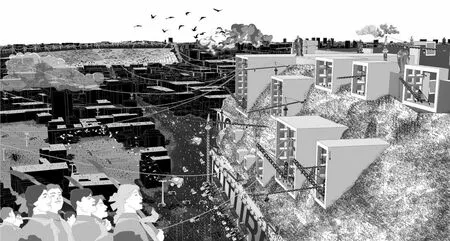

经济城堡——伦敦是全球主要的金融中心之一,每年为英国经济贡献约2 500亿英镑。根据英国保险业协会和英国环境署数据显示,自2000年以来发生的大洪灾包括2007年夏季洪灾(保险公司赔款30亿英镑)、2005年卡莱尔洪灾(损失金额达2.72亿英镑)和2009年11月发生的坎布里亚洪灾(损失金额达1.74亿英镑)。9“经济”城堡旨在使伦敦金融城(伦敦管理金融、控制稳定性的中央机构)持续运转。有序排列的城堡让人联想起如今的银行摩天大楼,它们表面平和,实则坚韧不拔,整齐排列形成洪水无法穿过的墙体,保护英国金融架构和软基础设施中最重要的部分——伦敦金融城、英格兰银行(创办年份排名全球第二的央行和排名全球第八的银行)和整个金融区。经济城堡同样象征着英国在“财政紧缩时期”和2016年“英国脱欧运动”等困难时期,始终保持着财政独立和自信。尽管英国在经济上始终与欧洲其他国家保持着独立关系,但保护英国利益的经济城堡的建造究竟会增强英国的经济独立性,还是会令英国自我封闭从而错失发展机遇?
知识城堡——“知识”城堡无畏地保护着大英图书馆、大英博物馆和伦敦大学,形成保护知识和文化的避难所。城墙将迎面涌来的洪水阻挡在外,保护珍贵文物、手工艺品、古书籍不被损坏,保留最真实、原始和可靠的英国知识和手稿遗产。在信息爆炸和实时电子通讯的年代,信息的“数字洪流”同样是一种威胁。保留实体书籍意味着保护知识的实体感和对信息的探索。“知识”城堡由英国市民人工挖掘的黏土砌筑而成,因此被市民亲切地称作“人民之墙”。形似阶梯井的开挖区被改建成农牧业合作中心。墙面和屋顶的立方体状容器内供人类居住,神像和宗教信物开始聚集,居民相信“神灵”会驱散入侵的洪水。
城墙之外的不同城堡之间,缆车系统将城市中庭与空中街道、冥想场所和能源中心相连接,以促进知识、商品和服务的交易。运输系统被视作一种冷静机制,能够使邻近地域保持一致的步调。在所有居民迁入三座城堡后,位于保护设施外围的伦敦将被遗弃。

在可能被视作反乌托邦的社会中,一种新型生态将战胜曾经的人造城市,在草木丛生的都市风光中繁荣发展,提供可持续性狩猎和耕种多样天然产品的机会。伦敦古老的文物和倾塌的标志性建筑物被藤蔓所包围,锈迹斑斑的自行车和其他机器弃置于伦敦街头,曾经的伦敦只残存于脑海之中。通过自然的修复、重建和有机更新,森林将现有的多个“城市绿肺”——肯辛顿花园、摄政公园、格林公园、维多利亚公园和数以千计的小型公园连接在一起,帮助恢复和保护这座曾经被污染城市的空气质量。新建的绿色基础设施包围着三座城堡,有望在泰晤士河决堤之际保护伦敦市。树干从地面吸收水分可降低洪水的整体高度。现有植被粗壮的树根缠绕着河岸和斜坡,能有效减少河岸倒塌和山体滑坡事件的发生。
英国环境署和英国多所院校已对其可行性开展广泛的研究。10因此,无需惊讶政府将会在乡村地区大范围植树造林,而非装饰性修剪树篱。前环境大臣Lord Rooker哀叹到,我们(英国政府)僱佣农民砍掉树木和树篱,将山坡上种满肥沃的牧草并饲养羊群,保留美丽的景观,然后又来责问为何英国频遭洪水侵袭。11
大洪灾的征兆是诺亚修建诺亚方舟的灵感来源,在长达“120年的时间里”,诺亚执著的等待着雨水的降临,不断种植树木,为巨轮的修建供应木材。很多人一定认为诺亚过于偏执或心存妄想。然而,随着古老传说的代代相传,诺亚听从神圣召唤的举动被认为十分明智:筹建诺亚方舟、带上地球的动物,从上帝因故而造的洪灾中顺利存活。在幻想之城,人类被迫抛弃原有家园、在惊恐和忧虑的影响下,寄居在保护性基础设施——三座城堡内。在城市的新秩序下,动植物群重新找回属于自己的领地,而在城堡之外的人群只能坐以待毙。
Ballard’s London is subject to a new Triassic age, under the environmental force even the human mind begins to regress. Melting ice caps have caused the cities of the west to plunge into a tropical lagoon-like state, and with that submersion came a rising dystopia. Pirates drain the lagoons and loot treasures from the past, whilst others occupy the upper floors of buildings which emerge from the water and vegetation.1Writer Will Self argues that given Ballard’s childhood in Shanghai where he had experienced regular events of flooding, and the formative and perhaps apocalyptic experiences of the Japanese invasion during World War II, ‘while he may not have consciously been constructing aneco-parable, such was the fertility of Ballard’s imagination he couldn’t help giving birth to a thriving example of the genre.’2Editions of the novel often have striking visions of a semi-submerged London as the cover image, London landmarks such as St.Paul’s Cathedral or Tower Bridge can be seen emerging from thick vines, a canopy of tropical eaves and a re flection of the dilapidated structures in the murky waters of the flood.
‘London is already feeling the effects of climate change. It is particularly vulnerable to flooding,subsidence, overheating and to water supply shortfalls notes the London Plan.3Understandably, the anxieties extend to very many cities and not just London that would be underwater when ice caps melt.How will sea level rise impacts the vulnerable inhabitants as well as the wealth of existing infrastructures in the cities? What are the viable measures to protect and adapt existing fl oodwalls, embankments and barriers, and also the time scales to implement new infrastructures? Retreat, attack or defend?4
Apprehension and scepticism caused by our remnant understanding of the 1928 Thames flood in London is still on-going; people drowned and thousands were made homeless when flood waters poured over the top of the Thames Embankment. The rising sea levels at the time coincided with a high spring tide as well as a storm surge that raised the water levels in the Thames Estuary. The situation was worsened by capital dredging which made it easier for sea-water to fl ow up the Thames during high tide. Plans to build the Thames Barrier began soon after the North Sea Flood disaster of winter 1953; the disaster caused substantial damage to factories, gasworks and electricity generating stations from Tilbury all the way to the East End.5
The Thames Barrier is one of the world’s largest movable flood resistant infrastructures – the row of science fiction-like mini-piers and silver pods that spans 520 meters protect London from tidal surges and storms. The barrier although fairly dormant is a powerful assurance. Having only been deployed 114 times between the 1980s and 2000s, there have been 65 closures since 2010, suggesting a strong,overall upward trend.6The barrier, together with 350 kilometers of flood walls and embankments, smaller barriers, pumping stations and flood gates, were constructed more than 30 years ago, when engineers planned for sea level rise of eight millimeters a year. However, the sea level rise in the Thames estuary over this century could be over 20 centimeters.7Although there will not be major adjustment to the existing system of defences until 2070, the UK’s Environmental Agency are now looking into the short,medium and long term recommendations of replacements and repairs made by the Thames Estuary 2100 Plan (TE2100). With such unfortunate sequences of events in the city’s past, it is no wonder that current news of rising sea levels play on Londoner’s anxieties and uncertainties.

‘The Paranoid City’ is one-third homage to Ballard, one-third speculation into the threat of nature and the resilience of cities, and one-third a provocation exercise in re-interpreting the notion of a ‘disaster’.The new inhabitable infrastructures, at once, protect parts of the urban fabric; and also safeguard the housing welfare of London’s inhabitants. Flooding has a bad reputation for targeting the poor, a major theme of Maggie Gee’s SF novel ‘The Flood’ (2004) which sees an open society threatened when repeated floods and hostile political situation eradicate all except the richest inhabitants who are, of course, protected by their higher position geographically. As evidenced in New Orleans with Hurricane Katrina in 2005, helpless demography that occupy susceptible topography and have poor infrastructure are most vulnerable. As climate-mania heightens to an overwhelming public insecurity,Londoner’s succumb to overprotective measures in order to safeguard their hard earned city habitat.Built-on anxieties, fears and foreseeing a great flood within a few short decades, three multi-use infrastructural ‘castles’ embrace and protect the inhabitants and core institutions of the city from being submerged. The strongholds recall the ‘Tower of Babel’8which was built by a united humanity, in an effort to reach a higher state and topography. London is dramatically transformed with farming moats and living castles that dominate the skyline, thus moving the city’s communities from relative lowrise housing into concentrated vertical living. The heritage and spirit of London is divided into three fundamental bodies to safeguard: the ‘Queen’, the ‘Economy’ and the ‘Knowledge’.
The Castle of the Queen– London is the seat of government and parliamentary activity for the UK.The inhabitable infrastructure of the ‘Queen’ protects Buckingham Palace, the Houses of Parliament and the spirit of her people. After a particularly vicious flood in 1236, many had to row around the Great Hall of the Houses of Parliament in boats. If this long anticipated flood were to occur and without the infrastructure in-place, then government ministers would have to be evacuated, leaving them completely helpless to aid the city and its inhabitants. The castle consists of several protective layers and elements. Within the walls are accropodes, concrete breakwater units that collectively reduce the intensity of incoming waves. The armours also act as ‘nesting’ stopovers for migrating birds from the Northern Hemisphere. On top of the accropodes, lies a living vertical garden teeming with life; when the flood emerges, these patterned gardens peel o ff the walls and become in flatable grass fl oats. An armada worth of boats strategically hang within the arches above the walls, constantly swaying much like the pendulum of a clock. They, not only, serve as a further precautionary measure, but are perpetual reminders of the inevitable drawing closer. Being the constitutional monarch of England, Scotland,Wales and Northern Ireland – the Queen cultivates national identity and unity. The infrastructure, as with her majesty, commands widespread optimism and pride, bestowing its inhabitants with a collective sense of belonging, and staunchly protects London from the ‘Broken-Britain’ myth.
The Castle of Economy– London is one of the world’s leading financial centers, and contributes an estimated £250 billion to the UK economy each year. According to the Association of British Insurers(ABI) and the Environmental Agency (EA), major floods since 2000 including the 2007 summer floods have resulted in insurers paying out £3 billion, the 2005 floods in Carlisle costing £272 million, and the Cumbrian floods in November 2009 costing a further £174 million.9The infrastructure of ‘Economy’ aims to preserve the undying heartbeat of the Square Mile, the central body for managing financial stability.The ordered towers, reminiscent of the passive-aggressive dominance of existing banking skyscrapers,systematically line-up to form an impenetrable wall to the physical flood – protecting some of the UK’s most important financial framework and soft infrastructure: the City of London, The Bank of England (being the second oldest central bank in the world and the world's eighth oldest bank) and the whole financial district. Symbolically, it also represents the continuing financial independence and confidence that the UK maintains, amid the metaphorical flood of the ‘Age of Austerity’ and ‘Brexit’ in 2016. Despite the fact the UK has almost always distanced itself financially from the rest of Europe, is her financial independence strengthened by having the wall protecting British interests, or missing opportunities by closing itself in?
The Castle of Knowledge– The infrastructure of ‘Knowledge’ heroically defends the British Library,the British Museum, and the University of London, creating a protective sanctuary of knowledge and culture. The wall denies the oncoming fl oodwaters from causing physical damage to treasured relics and artefacts, and the age-old books – retaining authentic, original and reliable manuscripts of British knowledge and heritage. In a world where information is so abundant and readily accessible via electronic means, the ‘digital flood’ of information also becomes a threat. Retaining physical books means protecting the tactility of knowledge and quest for information. The infrastructure of ‘Knowledge’is a ffectionately known as ‘the people’s wall’ because of the collective efforts of the city’s inhabitants to build the entire castle from manually dug London clay. The excavated zones, reminisce of stepped wells, are adapted into cooperative hubs for agriculture and farming. Amongst the inhabited cubelike capsules in the wall and on rooftops, deities and religious objects started to accumulate – the inhabitants believe that the ‘guardians’ would ward o ff the impending flood.
Outside the walls between castles, a cable-cart system connects a series of urban atriums with sky streets, community contemplation units and energy hubs, to facilitate the trading of knowledge, goods and services. Viewed as a calming mechanism, the transport system also creates a constant pace between neighbouring realms. With every inhabitant concentrated within the three Castles, London outside the protective infrastructures is abandoned.
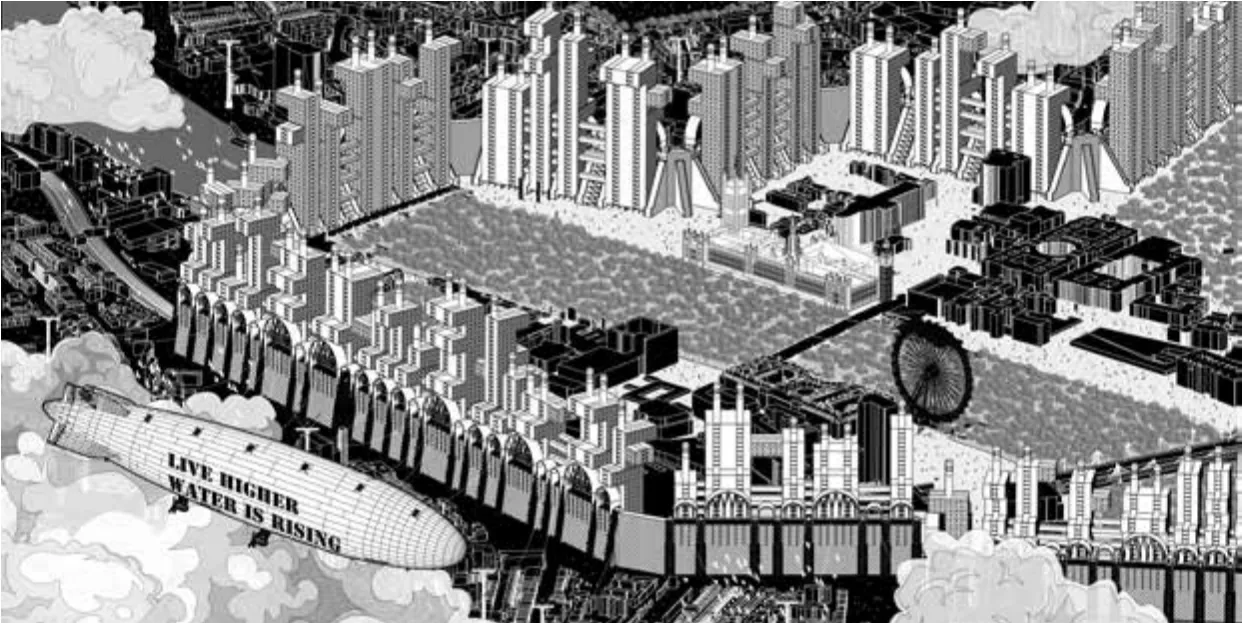

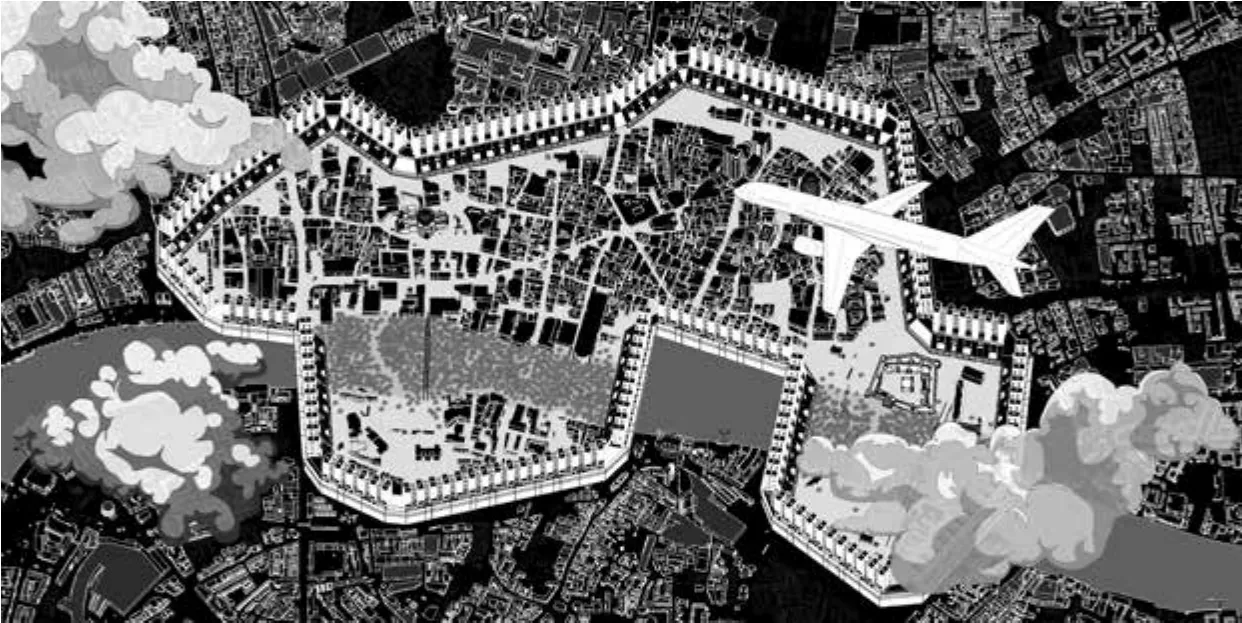

In what might be considered dystopia, a new ecology conquers the once man-made city and flourishes within a forested cityscape, providing opportunities for sustainable hunting and diverse cultivation of natural products. Relics of London’s forgotten past and fallen iconic structures are swathed in vines while rusticated bicycles and other machineries can be found along the desolate streets of London; we can only reminisce. Through nature’s resurgence, de-construction and organic renovation, the forest connects the multitude of existing ‘green lungs’ – Kensington Gardens, Regents Park, Green Park,Victoria Park and thousands of smaller squares help rejuvenate and protect the air quality of the oncepolluted city. Encircling the three Castles, the new green infrastructure has the potential to protect the city when the River Thames does eventually break its banks. Trees soak-up water from the ground,and the collective fauna can reduce the overall height of floodwaters. The strong roots of established vegetation binds together riverbanks and slopes, thus fewer collapses and landslides.
The Environment Agency and numerous UK universities have made extensive research into the potential.10Therefore, it is not surprising that the political inclination is to have effective planting in the countryside rather than decorative hedge-trimming. Lord Rooker, a former environment minister,bemoaned that ‘we [the UK Government] pay the farmers to grub up the trees and hedges; we pay them to plant the hills with pretty grass and sheep to maintain the chocolate box image, and then wonder why we've fl oods’.11
It was the promise of a great flood that inspired Noah to build his Ark; and for ‘one hundred and twenty years’, he waited for rain and planted trees to supply the timber for the enormous hull. To many, Noah must have seemed paranoid or delusional. However, as the ancient story goes, Noah was wise to heed the divine call: prepared the infrastructure, collected together the animals of the Earth and survived the deadliest of God’s purge. In The Paranoid City, man has abandoned their homes, and forced by their fear and anxieties to hide within the protective infrastructures of the three Castles. The new order of the city empowers fl ora and fauna to rediscover their rightful territories,while beyond the walls of assurance the populace can only wait.
注释:
1 JG Ballard, ‘The Drowned World’, Berkley Books, London, 1962
2 W Self, ‘Will Self on JG Ballard's The Drowned World’, The Telegraph, 31 August 2013 [http://www.telegraph.co.uk/culture/books/10273413/Will-Self-on-JG-Ballards-The-Drowned-World.html], retrieved 19 July 2016
3 The Mayor of London, ‘London’s Response to Climate Change’, The London Plan,Chapter 5, March 2016, p.176 [https://www.london.gov.uk/sites/default/ fi les/the_london_plan_malp_march_2016_-_chapter_5_-_londons_response_to_climate_change.pdf],retrieved 24 July 2016
4 Building Futures RIBA, ‘Facing Up To Rising Sea-Levels: Retreat? Defend? Attack?’,Institute of Civil Engineers, 2010 [www.buildingfutures.org.uk/assets/downloads/Facing_Up_To_Rising_Sea_Levels.pdf], retrieved 14 September 2012
5 D Hill, ‘Beyond the Thames Barrier: How safe is London from another major flood?’,Resilient Cities, The Guardian, 19 February 2015 [https://www.london.gov. https://www.theguardian.com/cities/2015/feb/19/thames-barrier-how-safe-london-major- fl ood-at-risk],retrieved 24 July 2016
6 D Hill, ‘Beyond the Thames Barrier: How safe is London from another major fl ood?’, Resilient Cities, The Guardian, 19 February 2015 [https://www.london.gov. https://www.theguardian.com/cities/2015/feb/19/thames-barrier-how-safe-london-major- fl ood-at-risk],retrieved 24 July 2016
7 The Thames Estuary 2100 Plan, ‘Managing Flood Risk Through London and The Thames Estuary’, The Environmental Agency (UK),24 June 2014, [https://www.gov.uk/government/publications/thames-estuary-2100-te2100/thames-estuary-2100-te2100], retrieved 24 July 2016
8 RT Pennock, ‘Tower of Babel: the evidence against the new creationism’, Cambridge, Mass.: MIT Press, 1999
9 ‘Massive rise in Britain's flood damage bill highlights the need for more help for flood vulnerable communities says the ABI’,Association of British Insurers: News, November 2010 [https://www.abi.org.uk/News/News-releases/2010/11/massive-rise-in-britainsflood-damage-bill-highlights-the-need-for-more-help-for-flood-vulnerable-communities-says-the-abi.aspx], retrieved 14 September 2012
10 R Harrabin, ‘Tree planting ‘can reduce flooding’, BBC News, 11 March 2016 [http://www.bbc.co.uk/news/scienceenvironment-35777927], retrieved 11 August 2016
11 R Harrabin, ‘Lord Rooker: Planting trees could stop flooding', BBC News, 23 January 2014 [http://www.bbc.co.uk/news/uk-25864631], retrieved 11 August 2016

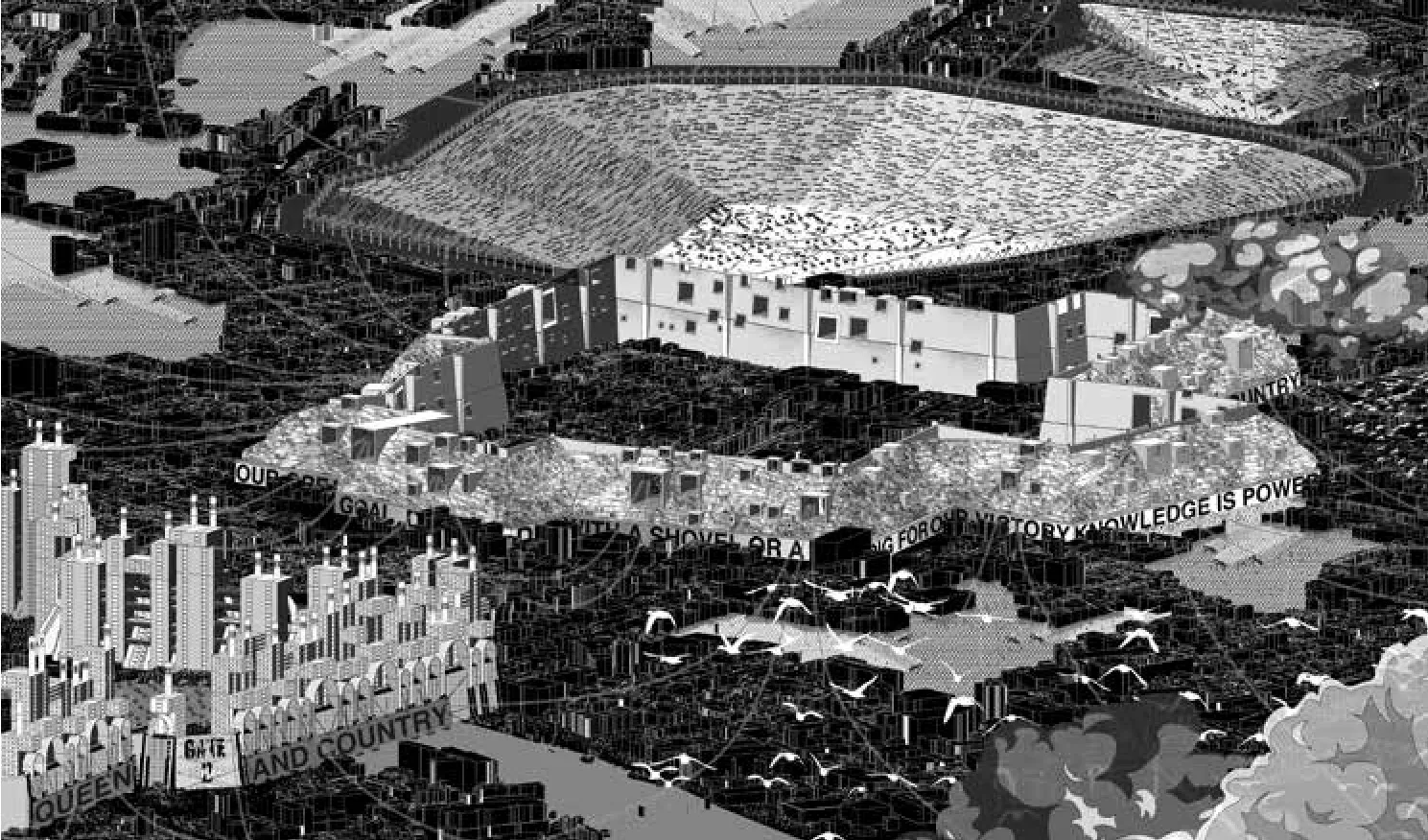
London Is Flooding?
Author: CJ Lim
Professor of Architecture and Urbanism at The Bartlett,UCL
Design team: CJ Lim with Samson Lau, Yu-Wei Chang, Eric Wong, Jens Kongstad Olesen"Inhabitable Infrastructures: Science fi ction or urban future?" ,Published by Routledge,2017 ISBN 978-1138119673
设计小组:CJ Lim, Samson Lau, Yu-Wei Chang, Eric Wong,Jens Kongstad Olesen
《宜居基础设施:科幻还是未来?》,劳特利奇出版,2017 ISBN 978-1138119673

